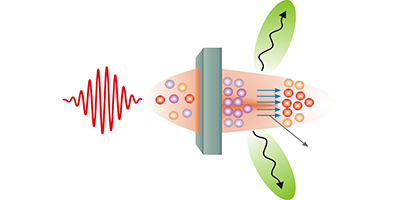http://thznetwork.net/index.php/archives/1799
 Image courtesy of Amrutha Gopal/Friedrich Schiller University Jena | Published Article: Observation of Gigawatt-Class THz Pulses from a Compact Laser-Driven Particle Accelerator |
Presently, the most powerful THz sources are at expensive, large-scale accelerator facilities, which generate THz radiation by bending a beam of relativistic electrons with a magnet. Gopal et al.’s solution instead exploits a high-power laser available at the Friedrich Schiller University Jena. The authors focus the laser’s femtosecond pulses onto micrometer-thick metallic foils. The intense pulses ionize the material, creating hot plasma that emits THz radiation. The setup delivers ten THz pulses per second with a broad spectrum (0.3–30 THz). Since the energy is concentrated in pulses only about half a picosecond long, their peak power is close to a gigawatt.
The scheme also generates a synchronous beam of energetic ions, which suggests an intriguing medical application: the THz beam could be used for detecting cancerous cells on human skin (which reflect THz wavelengths differently than normal cells), while the ions could be directed selectively at such cells for simultaneous treatment. – Matteo Rini
No comments:
Post a Comment